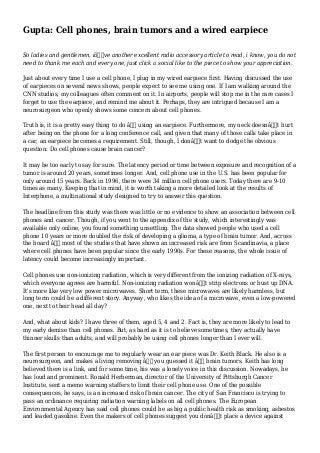
Gupta: Cell phones, brain tumors and a wired earpiece
- 1. Gupta: Cell phones, brain tumors and a wired earpiece So ladies and gentlemen, i’ve another excellent radio accessory article to read, i know, you do not need to thank me each and every one, just click a social like to the piece to show your appreciation. Just about every time I use a cell phone, I plug in my wired earpiece first. Having discussed the use of earpieces on several news shows, people expect to see me using one. If I am walking around the CNN studios, my colleagues often comment on it. In airports, people will stop me in the rare cases I forget to use the earpiece, and remind me about it. Perhaps, they are intrigued because I am a neurosurgeon who openly shows some concern about cell phones. Truth is, it is a pretty easy thing to do – using an earpiece. Furthermore, my neck doesn’t hurt after being on the phone for a long conference call, and given that many of those calls take place in a car, an earpiece becomes a requirement. Still, though, I don’t want to dodge the obvious question: Do cell phones cause brain cancer? It may be too early to say for sure. The latency period or time between exposure and recognition of a tumor is around 20 years, sometimes longer. And, cell phone use in the U.S. has been popular for only around 15 years. Back in 1996, there were 34 million cell phone users. Today there are 9-10 times as many. Keeping that in mind, it is worth taking a more detailed look at the results of Interphone, a multinational study designed to try to answer this question. The headline from this study was there was little or no evidence to show an association between cell phones and cancer. Though, if you went to the appendix of the study, which interestingly was available only online, you found something unsettling. The data showed people who used a cell phone 10 years or more doubled the risk of developing a glioma, a type of brain tumor. And, across the board – most of the studies that have shown an increased risk are from Scandinavia, a place where cell phones have been popular since the early 1990s. For these reasons, the whole issue of latency could become increasingly important. Cell phones use non-ionizing radiation, which is very different from the ionizing radiation of X-rays, which everyone agrees are harmful. Non-ionizing radiation won’t strip electrons or bust up DNA. It's more like very low power microwaves. Short term, these microwaves are likely harmless, but long term could be a different story. Anyway, who likes the idea of a microwave, even a low-powered one, next to their head all day? And, what about kids? I have three of them, aged 5, 4 and 2. Fact is, they are more likely to lead to my early demise than cell phones. But, as hard as it is to believe sometimes, they actually have thinner skulls than adults, and will probably be using cell phones longer than I ever will. The first person to encourage me to regularly wear an ear piece was Dr. Keith Black. He also is a neurosurgeon, and makes a living removing – you guessed it – brain tumors. Keith has long believed there is a link, and for some time, his was a lonely voice in this discussion. Nowadays, he has loud and prominent. Ronald Herberman, director of the University of Pittsburgh Cancer Institute, sent a memo warning staffers to limit their cell phone use. One of the possible consequences, he says, is an increased risk of brain cancer. The city of San Francisco is trying to pass an ordinance requiring radiation warning labels on all cell phones. The European Environmental Agency has said cell phones could be as big a public health risk as smoking, asbestos and leaded gasoline. Even the makers of cell phones suggest you don’t place a device against
- 2. your head, but rather advocate holding it 5/8 to a full inch away. Many will roll their eyes at this, scoffing at the precautionary principle on display here. Fair enough. Still, I like my wired earpiece, and I don’t have to turn my life upside down to use it. I also text and email a lot more, because my kids rarely allow me to have a phone conversation. Speaking of kids, you will probably see mine using earpieces too, when my wife and I decide they are old enough to use one, which isn’t in the foreseeable future. you can find more information from this place Here